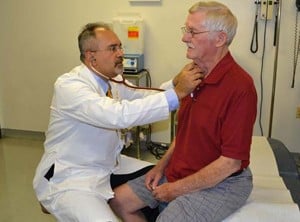‘Pathway’ Helps Crossett Man Survive Ruptured Aorta
| When Frank Englerth’s aorta began to rupture, the stabbing pain high in his back woke him in the middle of a cold February night.
It was the beginning of what could have been the end for Englerth, 74, who lives on the Saline River deep in southeastern Arkansas, nearly a three-hour drive from Little Rock. Although the odds were against him, Englerth had luck on his side that night, said Ahsan Ali, M.D., the University of Arkansas for Medical Sciences (UAMS) vascular surgeon who performed emergency surgery on Englerth.

Ahsan Ali, M.D., activated UAMS’ Aortic Pathway to help save Frank Englerth (right), who had a ruptured aorta.
The aorta is the body’s largest vessel, responsible for carrying blood out of the heart. When it ruptures, people may have only minutes to live, depending on the size of the rupture. Patients who make it to the hospital still alive have only about a 25 percent chance of surviving. In addition to the pain, Englerth was nauseous that night. When the nausea subsided, he went to his kitchen for water and passed out before making it to the sink. By happenstance his son was staying overnight, and the commotion of Englerth and a bar stool falling to the floor woke him. Englerth regained consciousness and told him to call 911.
At the Ashley County Medical Center in Crossett, Englerth was seen by Robert Garcia, M.D., a family medicine physician. Englerth remembers that Garcia worked quickly to diagnose his condition. A CT image revealed the ruptured aorta.
Garcia discussed Englerth’s condition with Ali at UAMS, who activated the “Aortic Pathway,” an emergency protocol that involves a multidisciplinary team and that was formally implemented in April 2010. The Aortic Pathway was established to streamline emergency transports, admissions and surgical readiness when immediate treatment is necessary to save a life.
“Dr. Garcia told me I was in bad shape; I had a leaking aneurysm on my aorta, and a medevac helicopter was on the way,” Englerth said. Englerth was conscious when the helicopter landed at UAMS, and he still remembers the scene. “When they landed it looked like the Army out here,” Englerth said. “There must have been 10 people there waiting for me. It was just zoom zoom, and I was in the operating room in probably less than five minutes.”
The Aortic Center showcases UAMS’ unparalleled ability in Arkansas to provide emergency treatment of the most complex aortic cases thanks to a multitude of specialists. The Aortic Center is staffed by doctors representing vascular surgery, thoracic surgery, cardiology and interventional radiology.
Englerth was taken directly from the hospital to the operating room, where Ali and the surgical staff were waiting. He arrived at 8 a.m., and the surgery to repair the rupture began at 8:23 a.m.
“An aortic emergency is life threatening,” Ali said. “Each second counts, literally.”
“I was lucky, and I was lucky that I got Dr. Ali,” Englerth said. “That’s what I told him, and you know what he told me? ‘There’s no sense in you buying a lottery ticket because you’ve used up your luck.'”
